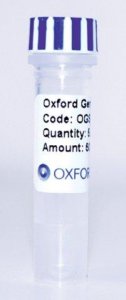The pSF-CMV-NH2-PPT-3XFLAG expression vector is a 4.6 kb derivative of pSF-CMV-Amp for transient expression of secreted N-terminal 3XFLAG fusion proteins in mammalian cells. This vector encodes three FLAG epitopes in tandem (DYKDHDG-DYKDHDI-DYKDDDDK), which results in increased sensitivity when using the anti-FLAG M2 antibody (catalogue number F3165). The third epitope includes the enterokinase recognition sequence, allowing cleavage of the 3XFLAG peptide from the purified fusion protein. The preprotrypsin (PPT) leader sequence precedes the 3XFLAG sequence and directs secretion of the fusion protein into the culture medium. pSF-CMV-NH2-PPT-3XFLAG is a shuttle vector, containing both E. coli and SV40 origins of replication, for propagation in bacterial and mammalian cells. Efficiency of replication and genomic integration is optimal when using an SV40 T antigen expressing mammalian host. The promoter regulatory region of the human cytomegalovirus drives transcription of FLAG fusion constructs.
Cloning in a gene: This plasmid contains a gene within the main multiple cloning site (NotI-ClaI). Any plasmid that we sell where the gene is this configuration will be located in the exact same position in relation to the start and stop codon of the gene. The only exceptions to this rule are fusions proteins where the fusion gene may be positioned at the front or end of the MCS to allow gene fusion.By positioning all of our genes in the same location it allows them to be transferred between plasmids using the same cloning method and restriction sites regardless of the plasmid being used from our product range. Inserting a new gene into this plasmid should be easily possible using a range of standard restriction enzyme sites that flank the gene currently in the vector.Multiple cloning site notes:In the multiple cloning site there are two important restriction sites called BsgI and BseRI sites. These sites both cut the DNA at the same position and cleave the stop codon of the gene in the multiple cloning site in this plasmid thereby producing a TA overhang. This overhang is compatible with any of our peptide or reporter fusion tag plasmids also cut with either of these enzymes. This allows seamless C-terminal fusions to be made with the gene in this multiple cloning site using a single cloning step from our C-terminal peptide and reporter tag product range. Normally the easiest method is to clone the C-terminal tag from our other plasmid products into this plasmid using BsgI or BseRI and the downstream ClaI restriction site.BseRI and BsgI sites are non-palindromic and cleave a defined number of bases away from their binding sites. This allows them to cut the upstream stop codon in the gene in this plasmid regardless of the gene sequence.
Sequence
Quick-reference Plasmid Map,
Please select the file type you require. For reference most cloning programs will import a .gb (Genbank) file and will show all of the plasmids features automatically when downloaded and imported.Genebank Vector Sequence File,FASTA Vector Sequence File,Full Plasmid Map,
Analysis Note
Looking for more vector options to move your experiments forward faster? Consider a custom cloning vector designed and built by Oxford Genetics™. Find out more at Oxford Genetics, - Sigma's partner for cloning and expression vectors for molecular biology and synthetic biology applications.
Oxford Genetics is a trademark of Oxford Genetics Ltd
Oxford Genetics is a trademark of Oxford Genetics Ltd
| recombinant | expressed in human cells |
| form | buffered aqueous solution |
| mol wt | size 4610 bp |
| conjugate | 3X FLAG tagged |
| Origin of replication | pUC |
| Peptide cleavage | EKT |
| Peptide tag location | N-terminal |
| Promoter | Promoter name: CMV
Promoter activity: constitutive
Promoter type: mammalian |
| bacteria selection | ampicillin |
| shipped in | ambient |
| storage temp. | 20°C |
| RIDADR | NONH for all modes of transport |
| Flash Point F | Not applicable |
| Flash Point C | Not applicable |

















































































































































